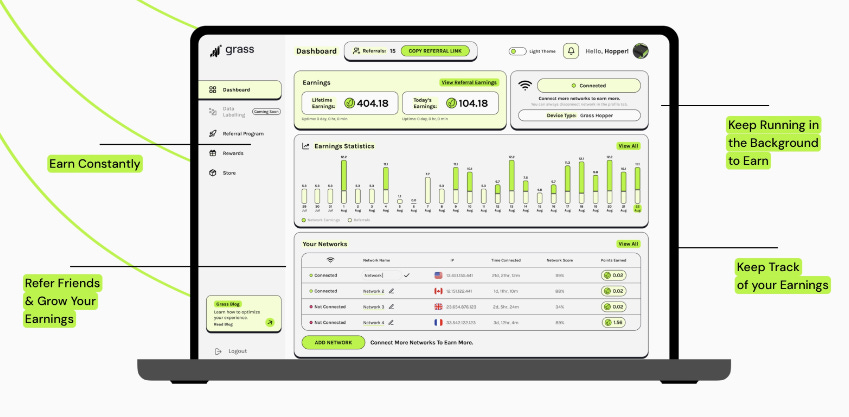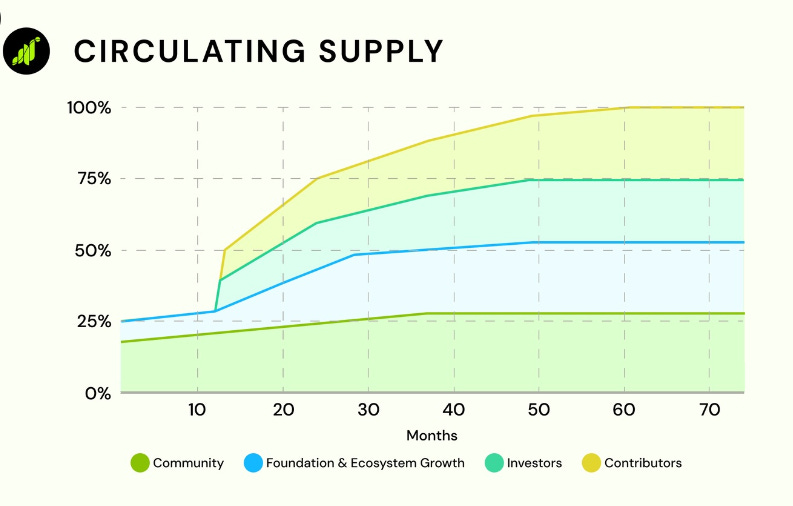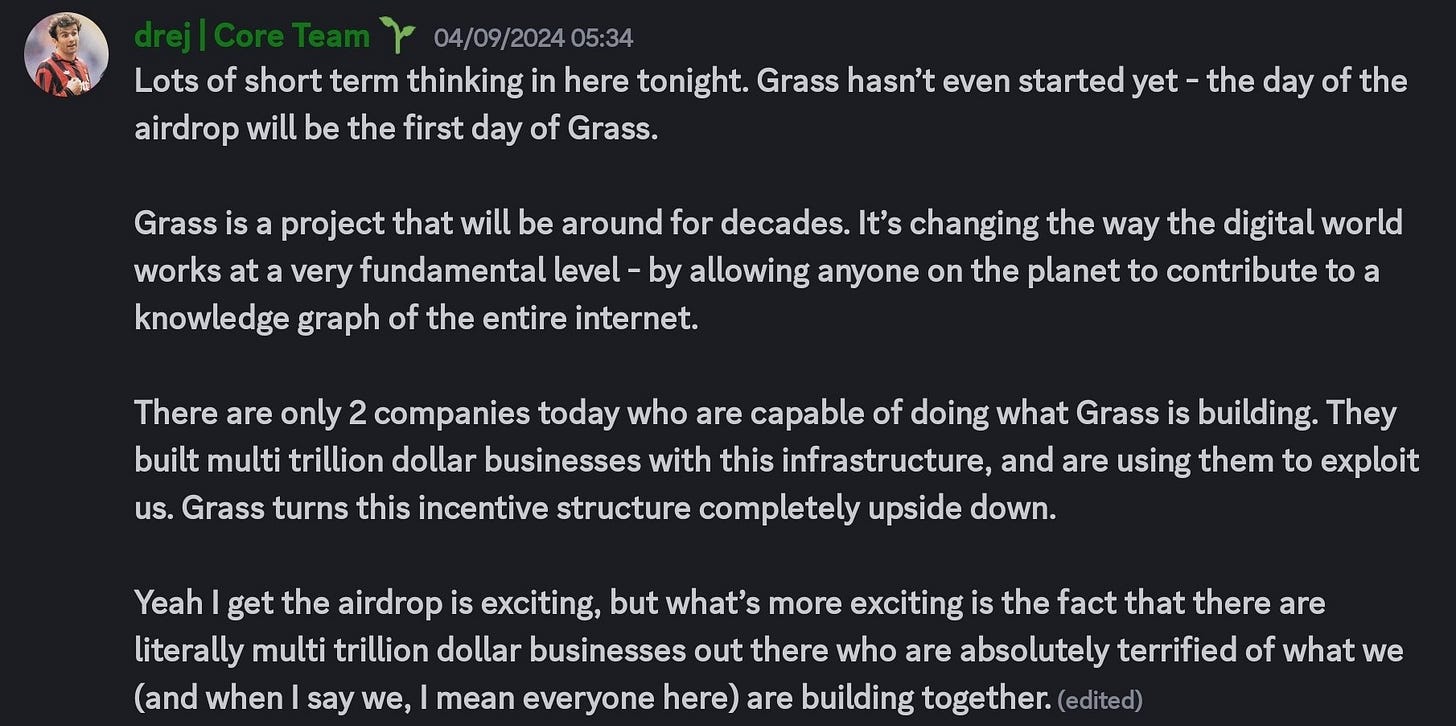How Grass Protocol Turns Your Bandwidth Into Passive Income and AI Power
Unlocking AI’s Future: Grass Protocol’s Real-Time Data and Rewards
What is Grass Protocol?
Grass is a decentralized platform where users can share their unused internet bandwidth. This bandwidth is utilized for collecting and processing public web data, which is then structured into datasets for training AI models. By contributing bandwidth, users earn rewards in the form of Grass Points or GRASS tokens.
Grass is revolutionizing the web and AI space by offering a user-owned, privacy-focused alternative to centralized data collection platforms.
Imagine your internet bandwidth is like farmland. You use some of it daily, but a large portion often lies unused, like idle land. Grass Protocol is the cooperative that helps you lease out this unused bandwidth to grow "data crops" for artificial intelligence (AI). In return, you earn rewards while contributing to a decentralized, user-owned network. This analogy captures the essence of Grass’s mission: to empower individuals to monetize their resources while advancing AI.Beyond offering passive income opportunities, Grass is pioneering Live Context Retrieval (LCR)—a technology that enables AI models to access and use real-time public web data. This innovation positions Grass as a leader in building the infrastructure for dynamic and adaptable AI systems. With millions of users already contributing, Grass is reshaping the AI and Web3 landscapes.
The Problem with Centralized Data Models
How Centralized Organizations Handle Data
Centralized organizations, like Google, Amazon, and Bright Data, dominate the data economy. These corporations control the majority of data collection, storage, and usage, profiting immensely while offering little to no benefits to the users who generate or contribute this data.
Data Collection Without Consent:
These organizations often collect user data indirectly through cookies, tracking scripts, and platform interactions.
Users are rarely compensated or even made fully aware of how their data is being used.
Monetization Without User Benefits:
Centralized companies sell or utilize this data to train proprietary AI models, creating a multibillion-dollar industry.
All profits go to these corporations, while users remain excluded from any economic rewards.
The Impact on Users
Lack of Control: Users have no say in how their data is used or shared.
Privacy Risks: Centralized systems often fail to protect user data, leading to data breaches and privacy violations.
Missed Opportunities: Despite generating valuable data, users are not compensated, while companies like Google generate billions in profits.
The Grass Alternative
Grass Protocol flips this model by:
Allowing users to own and monetize their unused bandwidth.
Providing full transparency on how data is collected and used.
Sharing the economic rewards directly with the contributors.
Grass enables a fairer, more ethical approach to data collection, empowering individuals instead of corporations.
Why Decentralized AI Data is the Future
Grass’s decentralized approach to AI data collection is superior to traditional centralized systems in several ways:
Democratization of Data Access:
Grass ensures that data is accessible to all developers, removing barriers created by centralized platforms like Google or Bright Data.
Ethical Data Practices:
Unlike centralized platforms that often collect user data without consent, Grass focuses on public data and rewards contributors fairly.
Resilience and Scalability:
Grass’s decentralized network is resistant to censorship and monopolistic control, making it more secure and adaptable.
Real-Time Adaptability:
Static datasets lose relevance quickly, but Grass’s LCR engine keeps AI models updated with live data.
Fair Incentives:
Contributors are rewarded with GRASS tokens, creating a sustainable and equitable ecosystem.
Achievements So Far
Grass Protocol has accomplished significant milestones during Stage 1 of its development:
Global Reach:
Grass has built a massive community of 2.8 million users across 190 countries, highlighting its scalability and inclusivity.
Record-Setting Airdrop:
Conducted the most widely distributed airdrop on Solana, distributing 100 million tokens (10% of the total supply) in Season 1.
Massive Data Contribution:
Users collectively scraped 100TB of public web data daily, powering AI model training on an unprecedented scale.
Open-Sourcing UpVoteWeb:
Grass made a dataset of 600 million Reddit posts and comments available on Hugging Face, democratizing access to high-quality data for AI developers.
How Grass Works
Grass enables users to monetize their unused bandwidth while contributing to a decentralized AI ecosystem. Here’s how it works:
Bandwidth Sharing:
Users install the Grass app (desktop or mobile) to securely share their unused internet bandwidth.
Data Collection:
Grass collects public web data using the shared bandwidth, turning it into structured datasets for AI models.
Privacy and Security:
Grass ensures that only public data is accessed, maintaining strict privacy standards.
Live Context Retrieval (LCR):
LCR allows AI models to access real-time public web data, ensuring they remain relevant and adaptable.
Grass’s Live Context Retrieval (LCR): Transforming AI
What is LCR?
Live Context Retrieval (LCR) is Grass’s ground-breaking engine that enables AI models to access real-time data from the public web. This capability addresses the limitations of traditional AI systems, which rely on static datasets that quickly become outdated.
How LCR Works:
Real-Time Data Access:
LCR retrieves live information from the internet, making AI models responsive to current trends and events.
Seamless Integration with AI Models:
Large language models (LLMs) can use LCR to enhance their outputs with up-to-date information.
Dynamic Applications:
Industries like finance, healthcare, and e-commerce benefit from AI systems powered by LCR’s real-time adaptability.
Why LCR Matters for AI
Live Data for Dynamic Needs:
In industries like e-commerce, healthcare, and finance, static data fails to capture real-time changes. LCR ensures that AI can react to live scenarios.
Universal Utility:
Every Fortune 500 company is likely to use LLMs in the future, and most of these applications will require real-time data. LCR makes this possible.
Unparalleled Impact:
Grass envisions a world where every AI model plugs into Grass, leveraging the entire internet for up-to-date information.
Funding and Tokenomics
Funding:
Total Funding: $4.5 million, including a $3.5M seed round led by Polychain Capital and Tribe Capital.
Partnerships: Collaborations with Hex Trust to scale infrastructure.
Tokenomics:
Grass operates with a total supply of 1 billion GRASS tokens:
Community Allocation: 30% (300M tokens) for user rewards.
Future Incentives: 17% (170M tokens) for rewarding early adopters.
Airdrops: 10% (100M tokens) distributed in Season 1, with Season 2 ongoing.
Router Rewards: 3% (30M tokens) for incentivizing bandwidth contributors.
Foundation Growth: 22.8% (228M tokens).
Early Investors: 25.2% (252M tokens).
Contributors: 22% (220M tokens) for core developers.
Airdrop Programs
Season 1 (Completed):
Distributed Tokens: 100M GRASS (10% of total supply).
Eligibility:
Early Grass Point earners.
GigaBuds NFT holders.
Users of Grass’s Desktop Node or Saga Application.
Season 2 (Ongoing):
Eligibility:
Existing GRASS token holders.
Active community participants.
Users completing tasks or whitelisted activities.
Details: Exact distribution is yet to be announced, but it builds on the success of Season 1.
Competitors in Web2 and Web3
While Grass Protocol stands out as a unique project, it operates in a competitive landscape where other platforms address similar aspects of data collection and monetization. However, there is no project exactly like Grass Protocol that combines decentralized bandwidth sharing, public web data collection, and AI integration.
Web2 Competitors
Google
Focus: Dominates the data collection and AI space through its vast infrastructure and proprietary datasets.
Comparison: Google’s centralized approach contrasts with Grass’s decentralized model. While Google locks data within its ecosystem, Grass aims to democratize access to public data, making it available to all developers.
Bright Data (formerly Luminati)
Focus: A centralized proxy network that gathers public web data for commercial use.
Comparison: Bright Data operates as a paid service where data is controlled by the company, whereas Grass enables users to share bandwidth and earn rewards in a decentralized manner.
Amazon Mechanical Turk
Focus: A platform for crowdsourcing tasks like data labeling and AI training.
Comparison: Mechanical Turk relies on manual contributions, while Grass automates the process of gathering public web data through bandwidth sharing.
Web3 Competitors
Hivemapper
Focus: A decentralized mapping network that uses user-contributed dashcam footage to build maps.
Comparison: Both Grass and Hivemapper rely on user contributions to create decentralized networks. However, Grass targets public web data for AI, while Hivemapper focuses on geographic mapping.
Theta Network
Focus: A decentralized video delivery and bandwidth sharing platform.
Comparison: Theta incentivizes users for sharing bandwidth for video streaming, while Grass focuses on bandwidth for AI data collection.
Grass’s Unique Position
Why Grass Stands Out:
While competitors like Google, Bright Data, and Hivemapper address aspects of data collection or monetization, Grass combines the following elements into one cohesive platform:
Decentralization: Unlike centralized platforms like Google, Grass ensures user ownership and transparency.
Real-Time AI Integration: Through Live Context Retrieval (LCR), Grass provides AI models with dynamic, real-time access to public data.
Fair Incentives: Grass rewards users for contributing bandwidth, creating an equitable ecosystem that benefits all participants.
Grass doesn’t just fill a niche—it creates an entirely new category of decentralized, user-powered AI data collection. This innovative model positions Grass as a pioneer in both Web3 and AI.
Next Steps and Upcoming Products
Grass Protocol is evolving rapidly, with several new products and features on the horizon to enhance its ecosystem and empower users. These developments aim to scale Grass’s infrastructure, increase user participation, and further its mission of building a decentralized, user-owned map of the internet.
1. Live Context Retrieval (LCR) Expansion
Grass plans to refine and expand its LCR engine, making it even more versatile for real-time data access. LCR will become the backbone for enabling:
Dynamic AI Use Cases: Enhanced support for industries like finance, healthcare, and e-commerce.
Integration with More AI Models: LCR will seamlessly plug into a broader range of AI frameworks, becoming an essential tool for developers globally.
2. Grass Mobile App Rollout
A mobile application is in development, allowing users to contribute unused mobile bandwidth.
Benefits:
Extends Grass’s reach to users primarily relying on mobile internet.
Offers real-time access to user earnings, tasks, and network activity.
3. Hardware Integration
Grass plans to introduce dedicated hardware solutions to streamline bandwidth sharing.
Examples:
Specialized routers or plug-and-play devices that optimize data contribution with minimal user intervention.
Impact:
Simplifies participation, especially for users with limited technical expertise.
Increases network efficiency and scalability.
4. Advanced Governance Tools
Grass will implement governance mechanisms, allowing GRASS token holders to:
Vote on Network Decisions: Influence key updates, such as reward structures, tokenomics, and product direction.
Shape Ecosystem Growth: Foster a more collaborative and user-driven development process.
5. Expanded Airdrop Programs
Following the success of Season 1, Grass plans to:
Continue Airdrop Rewards: Reward both new and existing users for their contributions.
Introduce Tiered Rewards: Higher rewards for active participants, incentivizing long-term engagement.
6. Live Context Retrieval (LCR) Product Features
Grass is developing Live Context Retrieval (LCR) into a standalone product that can be licensed by:
Enterprise Clients: Corporations needing real-time public data for proprietary AI systems.
Startups: Smaller teams requiring cost-effective, real-time data solutions.
Developers: Open APIs to integrate LCR directly into their applications.
7. New Datasets and Open-Source Initiatives
Grass will continue to open-source valuable datasets, like UpVoteWeb, to provide developers with high-quality resources.
Upcoming Datasets: Plans to release additional collections of structured public web data, broadening the scope for AI training and innovation.
Why Open Source Such a Valuable Dataset?
Grass’s decision to open-source UpVoteWeb reflects its commitment to two core principles:
1. Grass’s Core Values: Making the Web Public Again
Data as the Foundation: Data forms the foundational layer for AI models. By open-sourcing high-quality datasets, Grass is democratizing access to resources that were previously siloed in centralized organizations.
Levelling the Playing Field: This move empowers developers worldwide to innovate on a level playing field, fostering a more inclusive and diverse AI ecosystem.
2. The Short Half-Life of Data
Time-Sensitive Value: As Brad Burnham aptly stated, "Data is the most valuable it’ll ever be the moment it’s created." Static datasets lose relevance over time, which is why Grass focuses on real-time data retrieval instead of solely relying on static corpuses.
Beyond Static Data: Grass’s primary value lies in its ability to retrieve, structure, and deliver real-time information from the public web, keeping AI models relevant and effective.
Why LCR is the Future of AI
1. AI in Business
Grass anticipates that every major corporation will integrate LLMs into their operations. These models will require real-time data to maintain relevance and drive decision-making.
2. Beyond Large Data Corpuses
While static datasets are valuable for training, their utility is limited compared to real-time adaptability. LCR makes static corpuses dynamic, adding long-term value to AI models.
3. Internet as a Resource
Grass transforms the public web into a live resource that any AI model can access, creating endless possibilities for applications ranging from customer service to financial analysis and real-time event monitoring.
The Grass Vision: Leveraging the Entire Internet
Grass aims to turn the entire public web into a dynamic resource for AI models. By enabling LLMs to plug into Grass’s LCR engine:
Real-Time Data Integration: AI models can enhance any prompt with the most current and relevant information.
Global Accessibility: Developers across the world can use Grass to create cutting-edge applications without needing to build massive datasets from scratch.
Empowering Innovation: Grass lowers the barriers for AI innovation, enabling smaller teams and startups to compete with tech giants.
Market Sentiment and Potential
Bullish Indicators:
Grass’s Live Context Retrieval positions it as a critical infrastructure for AI.
Open-sourcing datasets like UpVoteWeb accelerates adoption and goodwill among developers.
Its decentralized approach ensures fairness and scalability.
Challenges:
Competing with centralized giants like Google and Bright Data.
Educating users about the benefits of decentralization and bandwidth sharing.
Potential Impact: Grass’s combination of LCR and decentralized AI data gives it the edge to disrupt the billion-dollar AI data market.
Conclusion
Grass Protocol doesn’t just solve the problems created by centralized data models—it creates an entirely new approach to data ownership. By allowing users to monetize their bandwidth, enabling real-time data access through LCR, and rewarding contributors, Grass is building a future where data is truly user-owned.
For developers, businesses, and contributors, Grass offers an innovative and equitable way to participate in building the future of AI. It’s not just a project; it’s a movement that ensures the public web stays public and the benefits of data collection are shared with the people who make it possible.
Want to join Grass and Earn passive income?
You can use this link to join!













